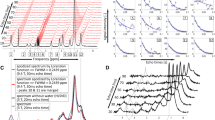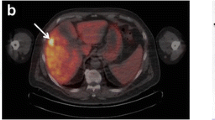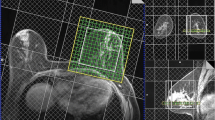Abstract
Objectives
To demonstrate the overlap of the hepatic and bile phosphorus (31P) magnetic resonance (MR) spectra and provide evidence of phosphatidylcholine (PtdC) contribution to the in vivo hepatic 31P MRS phosphodiester (PDE) signal, suggested in previous reports to be phosphoenolpyruvate (PEP).
Methods
Phantom measurements to assess the chemical shifts of PEP and PtdC signals were performed at 7 T. A retrospective analysis of hepatic 3D 31P MR spectroscopic imaging (MRSI) data from 18 and five volunteers at 3 T and 7 T, respectively, was performed. Axial images were inspected for the presence of gallbladder, and PDE signals in representative spectra were quantified.
Results
Phantom experiments demonstrated the strong pH-dependence of the PEP chemical shift and proved the overlap of PtdC and PEP (~2 ppm relative to phosphocreatine) at hepatic pH. Gallbladder was covered in seven of 23 in vivo 3D-MRSI datasets. The PDE gall/γ-ATPliver ratio was 4.8-fold higher (p = 0.001) in the gallbladder (PDEgall/γ-ATPliver = 3.61 ± 0.79) than in the liver (PDEliver/γ-ATPliver = 0.75 ± 0.15). In vivo 7 T 31P MRSI allowed good separation of PDE components. The gallbladder is a strong source of contamination in adjacent 31P MR hepatic spectra due to biliary phosphatidylcholine.
Conclusions
In vivo 31P MR hepatic signal at 2.06 ppm may represent both phosphatidylcholine and phosphoenolpyruvate, with a higher phosphatidylcholine contribution due to its higher concentration.
Key Points
• In vivo 31 P MRS from the gallbladder shows a dominant biliary phosphatidylcholine signal at 2.06 ppm.
• Intrahepatic 31 P MRS signal at 2.06 ppm may represent both intrahepatic phosphatidylcholine and phosphoenolpyruvate.
• In vivo 31 P MRS has the potential to monitor hepatic phosphatidylcholine.




Similar content being viewed by others
Abbreviations
- PtdC:
-
phosphatidylcholine
- PCr:
-
phosphocreatine
- PDE:
-
phosphodiesters
- PEP:
-
phosphoenolpyruvate
- Pi:
-
inorganic phosphate
- PME:
-
phosphomonoesters
- AMARES:
-
advanced method for accurate, robust and efficient spectral fitting
- B0 :
-
magnetic field strength
- MRSI:
-
magnetic resonance spectroscopic imaging
- GPC:
-
glycerol 3-phosphorylcholine
- GPE:
-
glycerol 3-phosphorylethanolamine
- MRS:
-
magnetic resonance spectroscopy
- 31P:
-
phosphorus
- TE:
-
echo time
- TR:
-
repetition time
- FWHM:
-
full width at half maximum
- SD:
-
standard deviation
References
Menon DK, Sargentoni J, Taylor-Robinson SD et al (1995) Effect of functional grade and etiology on in vivo hepatic phosphorus-31 magnetic resonance spectroscopy in cirrhosis: biochemical basis of spectral appearances. Hepatology 21:417–427
Taylor-Robinson SD, Sargentoni J, Bell JD et al (1997) In vivo and in vitro hepatic 31P magnetic resonance spectroscopy and electron microscopy of the cirrhotic liver. Liver 17:198–209
Sevastianova K, Hakkarainen A, Kotronen A et al (2010) Nonalcoholic fatty liver disease: detection of elevated nicotinamide adenine dinucleotide phosphate with in vivo 3.0-T (31)P MR spectroscopy with proton decoupling. Radiology 256:466–473
Szendroedi J, Chmelik M, Schmid AI et al (2009) Abnormal hepatic energy homeostasis in type 2 diabetes. Hepatology 50:1079–1086
Taylor-Robinson SD, Sargentoni J, Bell JD et al (1998) In vivo and in vitro hepatic phosphorus-31 magnetic resonance spectroscopy and electron microscopy in chronic ductopenic rejection of human liver allografts. Gut 42:735–743
Cox IJ, Sargentoni J, Calam J, Bryant DJ, Iles RA (1988) Four-dimensional phosphorus-31 chemical shift imaging of carcinoid metastases in the liver. NMR Biomed 1:56–60
Wylezinska M, Cobbold JFL, Fitzpatrick J et al (2011) A comparison of single-voxel clinical in vivo hepatic (31)P MR spectra acquired at 1.5 and 3.0 Tesla in health and diseased states. NMR Biomed 24:231–237
Dagnelie PC, Bell JD, Cox IJ et al (1993) Effects of fish oil on phospholipid metabolism in human and rat liver studied by 31P NMR spectroscopy in vivo and in vitro. NMR Biomed 6:157–162
Valkovic L, Gajdosik M, Traussnigg S et al (2014) Application of localized (31)P MRS saturation transfer at 7 T for measurement of ATP metabolism in the liver: reproducibility and initial clinical application in patients with non-alcoholic fatty liver disease. Eur Radiol 24:1602–1609
Taylor-Robinson SD, Thomas EL, Sargentoni J, Marcus CD, Davidson BR, Bell JD (1995) Cirrhosis of the human liver: an in vitro 31P nuclear magnetic resonance study. Biochim Biophys Acta 1272:113–118
London E, Feigenson GW (1979) Phosphorus NMR analysis of phospholipids in detergents. J Lipid Res 20:408–412
Metz KR, Dunphy LK (1996) Absolute quantitation of tissue phospholipids using 31P NMR spectroscopy. J Lipid Res 37:2251–2265
Ijare O, Bezabeh T, Albiin N, et al (2011) Potential of 31P magnetic resonance spectroscopy of bile in the detection of cholestatic diseases, Proceedings of the 19th Annual Meeting ISMRM , Montreal, Canada, 2011; 1002
Khan SA, Cox IJ, Thillainayagam AV, Bansi DS, Thomas HC, Taylor-Robinson SD (2005) Proton and phosphorus-31 nuclear magnetic resonance spectroscopy of human bile in hepatopancreaticobiliary cancer. Eur J Gastroenterol Hepatol 17:733–738
Bala L, Tripathi P, Bhatt G et al (2009) (1)H and (31)P NMR studies indicate reduced bile constituents in patients with biliary obstruction and infection. NMR Biomed 22:220–228
Sotirhos N, Herslof B, Kenne L (1986) Quantitative analysis of phospholipids by 31P-NMR. J Lipid Res 27:386–392
Small DM, Bourges M, Dervichian DG (1966) Ternary and quaternary aqueous systems containing bile salt, lecithin, and cholesterol. Nature 211:816–818
Prescot AP, Collins DJ, Leach MO, Dzik-Jurasz AS (2003) Human gallbladder bile: noninvasive investigation in vivo with single-voxel 1H MR spectroscopy. Radiology 229:587–592
Li Z, Vance DE (2008) Phosphatidylcholine and choline homeostasis. J Lipid Res 49:1187–1194
Lieber CS (2004) New concepts of the pathogenesis of alcoholic liver disease lead to novel treatments. Curr Gastroenterol Rep 6:60–65
Song J, da Costa KA, Fischer LM et al (2005) Polymorphism of the PEMT gene and susceptibility to nonalcoholic fatty liver disease (NAFLD). Faseb J 19:1266–1271
Chmelik M, Povazan M, Krssak M et al (2014) In vivo (31)P magnetic resonance spectroscopy of the human liver at 7 T: an initial experience. NMR Biomed 27:478–485
Schlemmer HP, Sawatzki T, Sammet S et al (2005) Hepatic phospholipids in alcoholic liver disease assessed by proton-decoupled 31P magnetic resonance spectroscopy. J Hepatol 42:752–759
Ugurbil K, Rottenberg H, Glynn P, Shulman RG (1978) 31P nuclear magnetic resonance studies of bioenergetics and glycolysis in anaerobic Escherichia coli cells. Proc Natl Acad Sci U S A 75:2244–2248
Bell JD, Cox IJ, Sargentoni J et al (1993) A 31P and 1H-NMR investigation in vitro of normal and abnormal human liver. Biochim Biophys Acta 1225:71–77
de Graaf RA (2007) In vivo NMR spectroscopy, 2nd edn. Wiley, West Sussex
Pollesello P, Eriksson O, Vittur F, Paoletti S, Geimonen E, Toffanin R (1995) Detection and quantitation of phosphorus metabolites in crude tissue extracts by 1H and 31P NMR: use of gradient assisted 1H-31P HMQC experiments, with selective pulses, for the assignment of less abundant metabolites. NMR Biomed 8:190–196
Turner BL, Mahieu N, Condron LM (2003) Phosphorus-31 nuclear magnetic resonance spectral assignments of phosphorus compounds in soil NaOH-EDTA extracts. Soil Sci Soc Am J 67:497–510
Rognstad R (1979) Rate-limiting steps in metabolic pathways. J Biol Chem 254:1875–1878
Trauner M, Fickert P, Wagner M (2007) MDR3 (ABCB4) defects: a paradigm for the genetics of adult cholestatic syndromes. Semin Liver Dis 27:77–98
Halilbasic E, Claudel T, Trauner M (2013) Bile acid transporters and regulatory nuclear receptors in the liver and beyond. J Hepatol 58:155–168
Shiffman ML, Sugerman HJ, Moore EW (1990) Human gallbladder mucosal function. Effect of concentration and acidification of bile on cholesterol and calcium solubility. Gastroenterology 99:1452–1459
Storey KB (2004) Functional metabolism: regulation and adaptation. Wiley, Hoboken
Hamasaki N, Wyrwicz AM, Lubansky JH, Omachi A (1981) A 31P NMR study of phosphoenolpyruvate transport across the human erythrocyte membrane. Biochem Biophys Res Commun 100:879–887
Dagnelie PC, Menon DK, Cox IJ et al (1992) Effect of L-alanine infusion on 31P nuclear magnetic resonance spectra of normal human liver: towards biochemical pathology in vivo. Clin Sci (Lond) 83:183–190
Watson R, Preedy V (2013) Bioactive food as dietary interventions for liver and gastrointestinal disease. Elsevier
Ludwig J, Ritman EL, LaRusso NF, Sheedy PF, Zumpe G (1998) Anatomy of the human biliary system studied by quantitative computer-aided three-dimensional imaging techniques. Hepatology 27:893–899
Chmelik M, Schmid AI, Gruber S et al (2008) Three-dimensional high-resolution magnetic resonance spectroscopic imaging for absolute quantification of 31P metabolites in human liver. Magn Reson Med 60:796–802
Sijens PE, Dagnelie PC, Halfwerk S, van Dijk P, Wicklow K, Oudkerk M (1998) Understanding the discrepancies between P-31 MR spectroscopy assessed liver metabolite concentrations from different institutions. Magn Reson Imaging 16:205–211
Solanky BS, Sanchez-Canon GJ, Cobbold JF et al (2012) Metabolic profiling of the rat liver after chronic ingestion of alpha-naphthylisothiocyanate using in vivo and ex vivo magnetic resonance spectroscopy. Toxicol Sci Off J Soc Toxic 126:306–316
Panda A, Jones S, Stark H et al (2012) Phosphorus liver MRSI at 3 T using a novel dual-tuned eight-channel 31P/1H coil. Magn Reson Med 68:1346–1356
Acknowledgments
We thank Vladimir Mlynarik for a helpful discussion. The scientific guarantor of this publication is Associate Professor Martin Krššák, Ph.D. The authors of this manuscript declare no relationships with any companies, whose products or services may be related to the subject matter of the article. This study was supported by the Vienna Spots of Excellence des Wiener Wissenschafts-und Technologie-Fonds (WWTF) – Vienna Advanced Imaging Center (VIACLIC), and the OeNB Jubilaeumsfond (grants #13629, #15455, and #15363). No complex statistical methods were necessary for this paper. Institutional review board approval was obtained. Written informed consent was obtained from all subjects in this study. Some study subjects or cohorts have been previously reported in Szendroedi and Chmelik et al. (Hepatology, 2009). Methodology: prospective / retrospective, experimental, performed at one institution.
Parts of this study were presented at the ISMRM, 2013, Salt Lake City (Chmelik, M. et al., Human bile phosphatidylcholine contributes to 31P MRS hepatic signal at 2.06 ppm. (e-poster ID#4090)).
Author information
Authors and Affiliations
Corresponding author
Rights and permissions
About this article
Cite this article
Chmelík, M., Valkovič, L., Wolf, P. et al. Phosphatidylcholine contributes to in vivo 31P MRS signal from the human liver. Eur Radiol 25, 2059–2066 (2015). https://doi.org/10.1007/s00330-014-3578-y
Received:
Revised:
Accepted:
Published:
Issue Date:
DOI: https://doi.org/10.1007/s00330-014-3578-y




